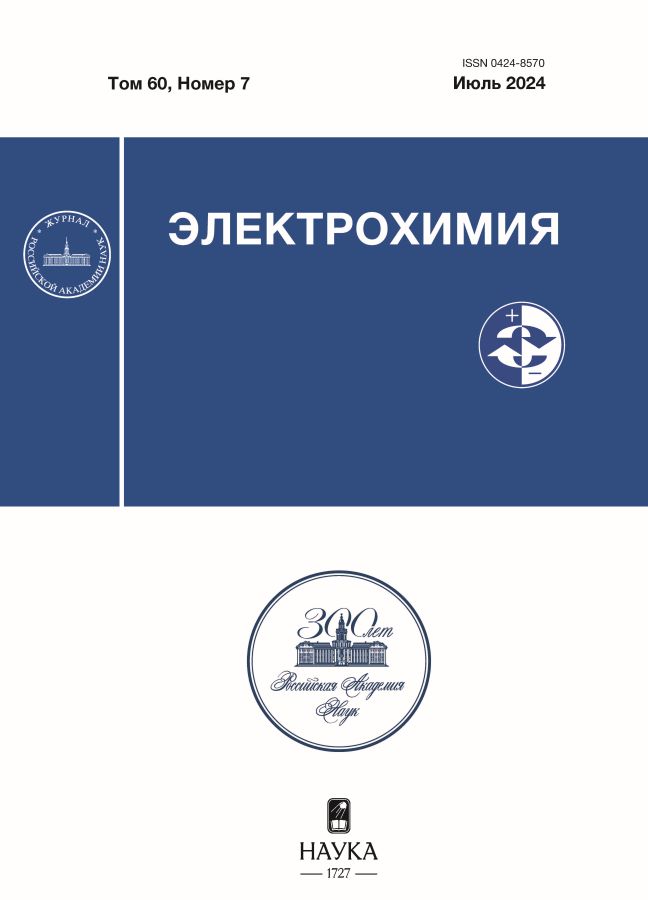Electrochemical reduction of carbon dioxide to formate in acetylene black gas diffusion electrode with a tin catalyst
- Authors: Kolyagin G.A.1, Taran O.P.1
-
Affiliations:
- Institute of Chemistry and Chemical Technology SB RAS, Federal Research Center “Krasnoyarsk Scientific Center of the SB RAS”
- Issue: Vol 60, No 7 (2024)
- Pages: 467-472
- Section: Articles
- URL: https://medjrf.com/0424-8570/article/view/671291
- DOI: https://doi.org/10.31857/S0424857024070019
- EDN: https://elibrary.ru/PQMHUW
- ID: 671291
Cite item
Abstract
A test study of a hydrophobized gas diffusion electrode with a tin catalyst deposited on acetylene black A437E was carried out in order to identify its potential for intensifying the process of electroreduction of CO2 to formate in acidic and alkaline aqueous solutions. Porous electrodes with a fluoroplastic content of 40 wt. %, thickness 0.5 mm, porosity 60 vol. % and tin content ≈0.7 mg/cm2, relative to the overall surface of the electrode were studied. It has been shown that, on this type of electrodes, it is possible to carry out the electroreduction of CO2 at a current density of up to 900 mA/cm2, at temperatures of 25–55°C with a formate flow yield of 74 to 96%. Electrolysis for 4 hours with a current density of 190 mA/cm2 resulted in a solution of potassium formate with a concentration of 1.58 M. In this case, an increase in the capacity of the double electrical layer was observed from 7 to 17 mF/cm2 and a decrease in current efficiency from 96 to 58%.
Full Text
About the authors
G. A. Kolyagin
Institute of Chemistry and Chemical Technology SB RAS, Federal Research Center “Krasnoyarsk Scientific Center of the SB RAS”
Author for correspondence.
Email: kolyagin@icct.ru
Russian Federation, Akademgorodok, 50, building 24, Krasnoyarsk, 660036
O. P. Taran
Institute of Chemistry and Chemical Technology SB RAS, Federal Research Center “Krasnoyarsk Scientific Center of the SB RAS”
Email: taran.op@icct.krasn.ru
Russian Federation, Akademgorodok, 50, building 24, Krasnoyarsk, 660036
References
- Корниенко, В.Л., Колягин, Г.А., Таран, О.П. Электрокаталитическое восстановление диоксида углерода до муравьиной кислоты на газодиффузионных электродах на основе Sn и Bi в водных средах (обзор). Электрохимия. 2022. Т. 58. С. 443. [Kornienko, V.L., Kolyagin, G.A., and Taran, O.P., Electrocatalytic reduction of carbon dioxide to formic acid on Sn- and Bi-based gas-diffusion electrodes in aqueous media (a Review), Russ. J. Electrochem., 2022. vol. 58. p. 647.]
- Xiang, H., Miller, H., A., Bellini, M., Christensen, H., Scott, K., Rasul, S., and Yu, E. H., Production of formate by CO2 electrochemical reduction and its application in energy storage, Sustainable Energy and Fuels, 2020, vol. 4, p. 277.
- Fernández-Caso, K., Díaz-Sainz, G., Alvarez-Guerra, M., and Irabien, A., Electroreduction of CO2: advances in the continuous production of formic acid and formate, ACS Energy Lett., 2023, vol. 8, p. 1992.
- Chatterjee, S., Dutta, I., Lum, Y., Lai, Z., and Huang, K-W., Enanling storage and utilization of Low – carbon electricity: power to formic acid, Energy Environmental Sci., 2021, vol. 14, p. 1194.
- Oßkopp, M., Lowe, A., Lobo, C. M. S., Baranyai, S., Khoza, T., Auinger, M., and Klemm, E., Producing formic acid at low pH values by electrochemical CO2 reduction, Journal of CO2 Utilization, 2022, vol. 56, p. 101823.
- Löwe, A., Rieg, C., Hierlemann, T., Salas, N., Kopljar, D., Wagner, N., and Klemm, E., Influence of temperature on the performance of gas diffusion electrodes in the CO2 reduction reaction, ChemElectroChem, 2019, vol. 6, p. 4497.
- Leonard, M. E., Clarke, L. E., Forner-Cuenca, A., Brown, S. M., and Brushett, F. R., Investigating Electrode Flooding in a Flowing Electrolyte, Gas-Fed Carbon Dioxide Electrolyzer, ChemSusChem, 2020, vol. 13, p. 400.
- Daele, K.V., Mot, B. D., Pupo, M., Daems, N., Pant, D., Kortlever, R., and Breugelmans, T., Sn-based electrocatalyst stability: a crucial piece to the puzzle for the electrochemical CO2 reduction toward formic acid, ACS Energy Lett., 2021, vol. 6, p. 4317.
- Колягин, Г.А., Таран, О.П. Электрохимическое восстановление диоксида углерода до формиата в кислом электролите в сажевом газодиффузионном электроде со свинцовым катализатором. Электрохимия. 2023. Т. 59. С. 606. [Kolyagin, G.A. and Taran, O.P., Carbon dioxide electroreduction to formate in acid electrolytes in the acetylene black gas-diffusion electrode with lead catalyst, Russ. J. Electrochem., 2023, vol. 59, p. 764.]
- Колягин, Г.А., Корниенко, В.Л. Влияние содержания политетрафторэтилена в композиционных пористых углеродных материалах на их структурные и электрохимические характеристики на примере процесса восстановления кислорода до пероксида водорода. Электрохимия. 2020. Т. 56. С. 520. [Kolyagin, G.A. and Kornienko, V.L., The effect of polytetrafluoroethylene content in porous carbon materials on their structural and electrochemical characteristics by the example of oxygen reduction to hydrogen peroxide, Russ. J. Electrochem., 2020, vol. 56, p. 485.]
- Бауэр, К. Анализ органических соединений, М.: Изд-во иностр. лит., 1953. 488 с. [Bauer, K., Analysis of organic compounds (in Russian), M.: Publ. house of foreign literature, 1953. 488 p.]
Supplementary files














